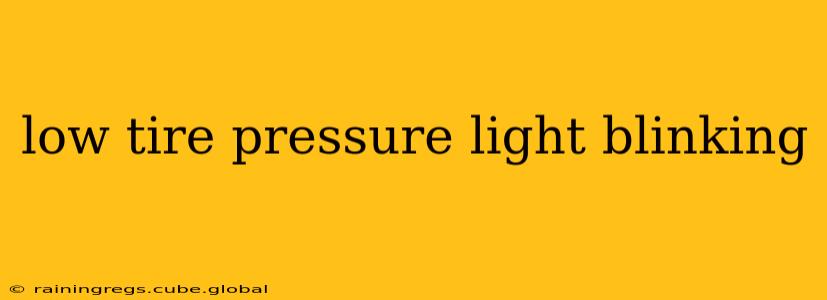A blinking tire pressure monitoring system (TPMS) light is a serious warning, indicating a critical problem that requires immediate attention. Unlike a steadily illuminated light, which usually signifies low tire pressure, a blinking light means you need to pull over safely as soon as possible. Ignoring this warning could lead to a blowout, loss of control, and potentially a serious accident.
What Causes a Blinking Tire Pressure Light?
Several factors can trigger a blinking TPMS light. The most common are:
-
Rapid pressure loss: This is the most urgent cause. A sudden drop in tire pressure, often due to a puncture, significant leak, or damage to the tire or wheel, will activate the blinking light.
-
TPMS sensor malfunction: The sensors themselves can fail, sending inaccurate readings or no readings at all to the vehicle's computer. This can cause the light to blink erratically or continuously.
-
System malfunction: Rarely, the TPMS system itself might have a fault, requiring a diagnostic check by a qualified mechanic.
How to Respond to a Blinking Tire Pressure Light
1. Immediate Actions:
- Pull over safely: Find a safe location away from traffic to stop your vehicle. Do not continue driving.
- Assess the situation: Visually inspect all four tires for any obvious signs of damage, such as punctures, cuts, or bulges. Look for embedded objects.
- Avoid driving on a flat tire: Driving on a significantly deflated tire can severely damage it, potentially leading to a dangerous blowout.
2. After Assessing the Tires:
-
If you identify a visible problem: Proceed with caution to change the tire, if possible and safe to do so. If you're uncomfortable or unable to change a tire yourself, call for roadside assistance.
-
If no obvious damage is visible: This is where things get trickier. You'll likely need professional help to diagnose the issue. The problem could be a slow leak, a faulty sensor, or a problem with the TPMS system itself.
-
Call a mechanic or roadside assistance: They can assess the situation, diagnose the problem, and provide the necessary repairs or replacements.
How Often Should I Check My Tire Pressure?
Regularly checking your tire pressure is crucial for safety and to prolong tire life. Aim to check your tire pressure at least once a month, and ideally before long trips. Remember to check the pressure when the tires are cold (meaning the car hasn't been driven for at least three hours).
What is the Recommended Tire Pressure?
The recommended tire pressure for your vehicle is usually found on a sticker located on the driver's side doorjamb, inside the glove compartment, or in your owner's manual. It's crucial to inflate your tires to the correct pressure specified by the manufacturer. Over-inflation or under-inflation can both negatively impact handling, fuel efficiency, and tire wear.
Can I Drive with a Blinking Tire Pressure Light?
No. A blinking TPMS light is a serious warning sign, and continuing to drive could be very dangerous. Pull over immediately and assess the situation. Driving on a flat tire can cause significant damage and potentially lead to a blowout.
My Tire Pressure Light is Blinking, but I Don't See Any Damage. What Could Be Wrong?
Even without visible damage, a blinking TPMS light points to a problem that requires professional attention. Possible causes include:
- Slow leak: A small puncture or leak may not be immediately visible, but could be causing a slow pressure drop.
- Faulty TPMS sensor: The sensor might be malfunctioning, providing inaccurate readings.
- System malfunction: There could be an issue with the TPMS system itself.
In conclusion, a blinking tire pressure light is not something to ignore. It's a crucial warning demanding immediate attention. Safety should always be your priority, so pull over, assess the situation, and seek professional help if necessary. Ignoring this warning can have serious consequences.
